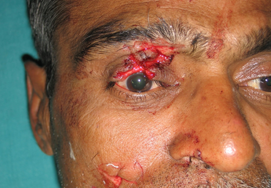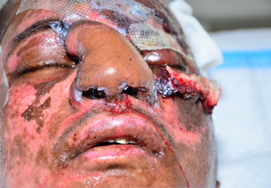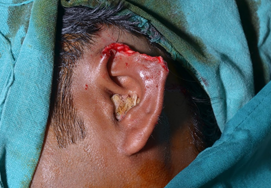Ear Reconstruction
Performed if you have underdeveloped ear at birth or have lost a normal ear through trauma, disease or accident

- What is Ear reconstruction?
- What are the types of the surgeries?
- Which individuals are suitable for the surgery?
- Which individuals are not suitable for the surgery?
- How should I prepare for the surgery?
- What will happen during the surgery?
- What is the aftercare of the surgery?
- What are the postsurgical considerations?
What is Ear reconstruction?
Ear reconstruction is an advanced kind of plastic surgery that involves the creation of the new ear that looks similar to a normal ear.It is one of the challenging and demanding surgery in plastic surgery
What are the types of the surgeries?
There are many factors that influence the treatment options, such as patient’s pathology, local tissue conditions of the skin and the preferences of you and your plastic surgeon.
There are three different types of ear reconstruction.
- Otoplasty– that improves the shape, position or misshapen ears caused by injury
- Microtia repair– treatment of congenital malformed ears
- Ear defects– that repairs ear defects caused by trauma or cancer surgery
The surgeons use two different strategies to reconstruct the ear in patients with microtia. In most of the cases, the new ear is created from the patient’s own tissue. Cartilage from the rib cage is usually used. In some cases, the surgeons opt for implants instead of own rib cartilage for better shape of the ear.
Which individuals are suitable for the surgery?
Ear reconstruction surgery is mainly performed in two cases:
- If you have underdeveloped ear at birth
- If you have lost the entire or part of the normal ear through trauma, disease or accident
Which individuals are not suitable for the surgery?
Ear reconstruction surgery has a high success rate. Nearly 90% of the patients are proved to get excellent results. However, patients with previous scarring or a low hairline may be less suitable for ear correction surgery and will need to speak to a specialist.
How should I prepare for the surgery?
Your doctor will give some basic instructions that you need to follow strictly before thesurgery.
- Avoid taking medications like aspirin to prevent the risk of internal bleeding
- Avoid certain herbal supplements that may interfere with the recovery
- Avoid eating or drinking few hours before the surgery as empty stomach reduces the risk of nausea caused by anaesthesia
- Take shower and hair wash the night before the surgery
- Ask your friends or family members to stay with you to drive back home after the surgery and to stay with you for few days.
What will happen during the surgery?
Plastic surgeons perform Otoplasty surgery.
Your surgeon starts the procedure with administering anesthesia, either local or general. Then he makes an incision behind the ear, in area where the ear is joined to the head. Then the surgeon removes required amount of skin and cartilage. In some cases, the surgeon may trim the cartilage shaping into a more desirable form and then pin the cartilage back with permanent sutures to secure the cartilage. In some cases, he may not remove any cartilage at all and instead use stitches to hold the cartilage permanently in place. Then he applies sutures to hold the ear in the desired position until it heals completely.
Mictrotia repair is done using following techniques:
Rib cartilage reconstruction
This procedure requires two to four surgeries and is usually performed in children between the ages of 10 to 16. First the surgeon creates an incision in the child’s chest and removes the cartilage from several of the ribs. He then uses this cartilage to fabricate a new ear by carving and suturing it carefully to match the healthy ear. He then creates a pocket of skin and places the new ear in this pocket.
Medpor ear reconstruction
In this technique, the surgeon creates a new ear framework using a biocompatible polyethylene and places the framework on the patient’s head. He then grafts the patient’s own tissue to integrate with the surrounding skin and blood vessels. This offers minimal scarring.
What is the aftercare of the surgery?
You should follow the surgeon’s instructions strictly to avoid complications after the surgery
- Do not worry if there is swelling in the ear regionas it will reduce within few days.
- Clean the ear gently with a cotton bud to prevent build up of dead tissue.
- Avoid activities like swimming, contact sports for few weeks until the era heals completely.
- Avoid direct sunlight where possible for several months after the surgery.
- Use clothes that button up from front to avoid pulling the clothes over the head and indirectly damage the new ear.
What are the postsurgical considerations?
- Soft dressings will be applied to the ears for a few days. You may experience mild discomfort for few days.
- Your sleep patterns may be disturbed as you cannot put any pressure on the ear areas. You surgeon may recommended headbands to hold the ears in the desired position for two weeks after the surgery.
- The risks associated with the surgery are minimum. You may get a thin to wide scar behind the ear after healing. Do not worry, as this is a natural crease behind the ear and the problem of visibility is limited.
- It is very important to follow the doctor appointment and report immediately if there are any signs of:
- Pain in the chest area
- Signs of exposed cartilage
- Signs of infection such as redness, swelling or discharge from the ear









